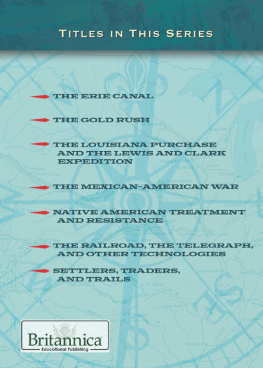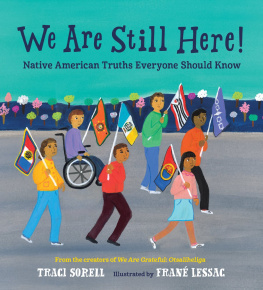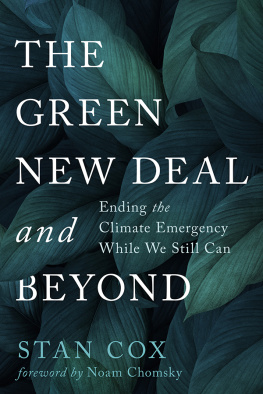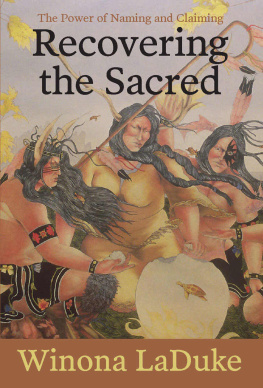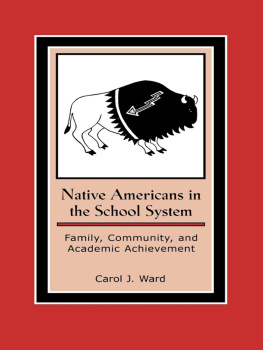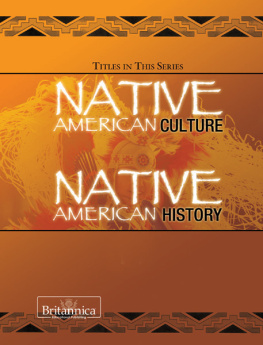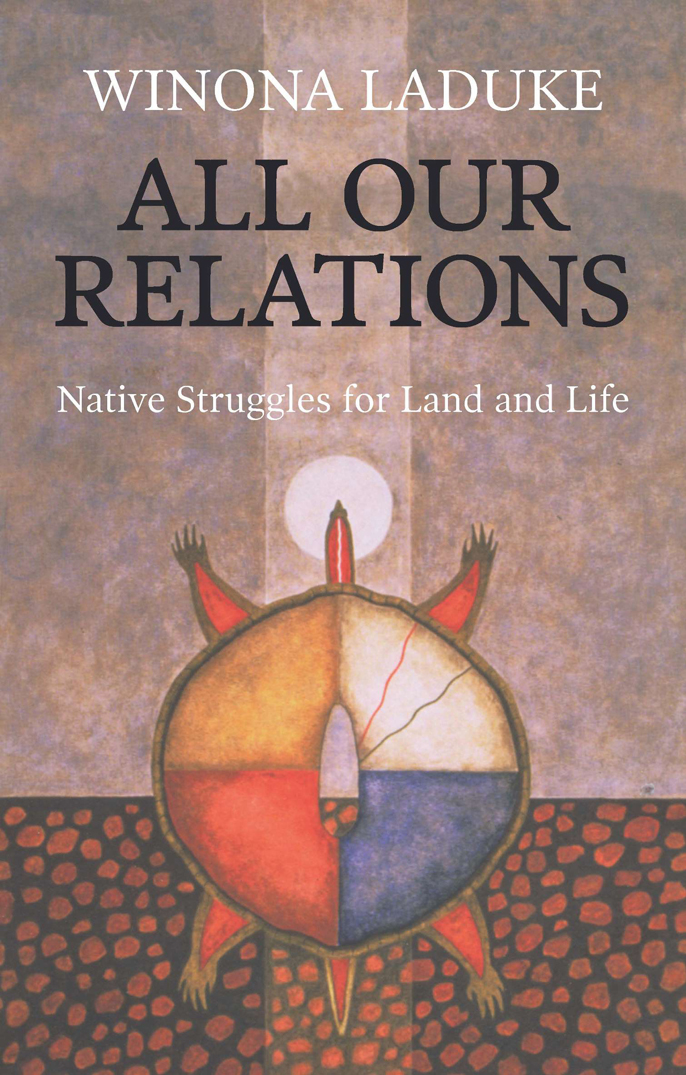
1999 Winona LaDuke
First published 1999 by South End Press, Cambridge, Massachusetts.
Cover art, The Turtle, by Ojibwa artist Joe Geshick
Maps by Zoltan Grossman of the Midwest Treaty Network in Madison,
Wisconsin. www.treaty.indigenousnative.org.
This edition published in 2015 by
Haymarket Books
P.O. Box 180165
Chicago, IL 60618
773-583-7884
www.haymarketbooks.org
ISBN: 978-1-60846-661-0
Trade distribution:
In the US, Consortium Book Sales and Distribution, www.cbsd.com
In Canada, Publishers Group Canada, www.pgcbooks.ca
In the UK, Turnaround Publisher Services, www.turnaround-uk.com
All other countries, Publishers Group Worldwide, www.pgw.com
This book was published with the generous support of Lannan Foundation and Wallace Action Fund.
About the Cover Art:
The Turtle was created to honor the Earth: Turtle Island. The turtle is a geat healer and teacher on our spiritual journey. Its pace reminds us to slow down and pay attention as we interact with the world.
The turtle shows us everything we need is always within us. The spiritual journey results when our inner life connects with out outer surroundings. Our goal is to find the balance and live with the tension between social turbulence (the red rocks) and serenity (the open sky).
Joe Geshick
Library of Congress Cataloging-in-Publication data is available.
10 9 8 7 6 5 4 3 2 1
Table of Contents
Guide
Contents
Praise for All Our Relations
A brilliant, gripping narrative ... I urge that everyone read [All Our Relations] ... which describes the ravages of corporations and government activity on the reservations of our first natives. This is a beautifully written book.... As Winona LaDuke describes, in moving and often beautiful prose, [these] misdeeds are not distant history but are ongoing degradation of the cherished lands of Native Americans.
Ralph Nader
As Winona LaDukes All Our Relations shows, a vital Native American environmentalism is linking indigenous peoples throughout North America and Hawaii in the fight to protect and restore their health, culture, and the ecosystems on their lands. LaDuke herself is a member of the Anishinaabeg nation and was Ralph Naders Green Party running mate in 1996. These Native American activists take inspiration from their forebears responsible treatment of natural systems, based on a reverence for the interconnectedness of all life forms.
The Nation
In this thoroughly researched and convincingly written analysis of Native American culture ... LaDuke demonstrates the manners in which native peoples face a constant barrage of attacks that threaten their very existence.
Choice
[LaDuke presents] strong voices of old, old cultures bravely trying to make sense of an Earth in chaos.
Whole Earth
With a good ear and sharp eye, LaDuke introduces us to Native activists and records gross environmental abuse and creative resistence. By placing people in the center of the industrial soup, LaDuke tells a story that has not been told before in this way.
Radcliffe Quarterly
A rare perspective on Native history and culture.
Sister to Sister
LaDuke unabashedly confronts spiritual and political grassroots missions with a tenacity that, as she explains, springs up from devotion to the land.
City Pages
A thoughtful, candid, in-depth account of Native resistance to environmental and cultural degradation ... LaDuke provides a unique understanding of Native ideas ... offering a beautiful and daring vision of political, spiritual ... transformation.
Midwest Book Review
LaDuke presents an unblinking review of the history of the toxic invasion of Native America by corporations and their supporting politicians ... The book is a record of the long, tedious, disheartening, but stubborn struggle of Native Americans.
The Diversity Factor
All Our Relations is a wonderful read, and an important book both for telling a story of plunder and exploitation too often forgotten, and because, as LaDuke notes, it is really about America.
Focus on the Corporation
LaDuke offers a jolt of reality ... In her eloquent new book ... LaDuke documents the historic and ongoing process of Native American dispossession.
ZNet
Acknowledgements
In my life, I have had the honor of meeting and working with a great number of courageous, visionary, and good hearted people. Their struggles to preserve that which they value, to live in dignity, and to ensure that a good way of life is passed to their descendants have been a constant source of inspiration. Some of these people I attempt to honor with my words in this book. I hope I do so with some integrity.
Others remain constant fires in their homelands, in our memories, and in our hearts. Some include: Phillip Deere, Bill Wapepah, Arlene Logan; Janet McCloud, my parents, Betty and Peter LaDuke Westigard, Helen Bernstein, Vincent LaDuke, Terri LaDuke, Anne Dunn, Priscilla Settee, Agnes Williams, Cecilia Rodriguez, Cynthia Perez, Lorna Hanes, Lisa Jackson, Sharon Asetoyer, Mililani Trask, Luana Busby, Paul Bogart, and others who love me and support me with unwavering patience. For their spiritual guidance to our community, Tommy Stillday and Eddie Benton Benai.
Special thanks to Jose Barriero who first published my writings, Jimmie Durham, John Redhouse, Mark Tilsen, Ward Churchill, Paul DeMain, Sluggo, Rory OConnor, and others who urged me to continue writing. To Carrie Dann, Roberta Blackgoat, Suzanna Santos, Margaret Flint Knife Saluskin, Ted Strong, Tom Goldtooth, Louise Erdrich, Ralph Nader, and many others for their tenacity and the light that shines through us all. And especially Faye Brown, Kevin Gasco, Nilak Butler, Lori Pourier, Amy Ray, Emily Saliers, and my WELRP staff: Donna Cahill, Florence Goodman, Ronnie Chilton, Pat Wichem, Juanita Lindsay, Robynne Carter, and Joanne Mulbah, and my children, for all their work, love, and beauty. This book is theirs too.
Finally, deep appreciation to Idelisse Malve and the Tides Foundation for their generous support, which allowed Honor the Earth to co-publish this book. And miigwech to Sonia Shah at South End Press for her patience, good eye, and commitment, and to Allison Garber, the footnote queen.
Dedicated to three fine friends who now live in the spirit world.
Ingrid Washinawatok-El Issa,
who resonated the sun in her warmth and love;
Walt Bresette, who like the North Star, showed a clear path; and
Marsha Gomez, whose hands were the Earth.
And to those yet unborn.
We are a part of everything that is beneath us, above us, and around us. Our past is our present, our present is our future, and our future is seven generations past and present.
Haudenosaunee teaching
T he last 150 years have seen a great holocaust. There have been more species lost in the past 150 years than since the Ice Age. During the same time, Indigenous peoples have been disappearing from the face of the earth. Over 2,000 nations of Indigenous peoples have gone extinct in the western hemisphere, and one nation disappears from the Amazon rainforest every year.
There is a direct relationship between the loss of cultural diversity and the loss of biodiversity. Wherever Indigenous peoples still remain, there is also a corresponding enclave of biodiversity. Trickles of rivers still running in the Northwest are home to the salmon still being sung back by Native people. The last few Florida panthers remain in the presence of traditional Seminoles, hidden away in the great cypress swamps of the Everglades. Some of the largest patches of remaining prairie grasses sway on reservation lands. One half of all reservation lands in the United States is still forested, much of it old-growth. Remnant pristine forest ecosystems, from the northern boreal forests to the Everglades, largely overlap with Native territories.


